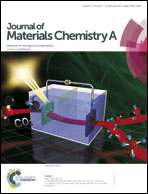Modulating the atomic and electronic structures through alloying and heterostructure of single-layer MoS2†
Abstract
Among dozens of transition metal dichalcogenides (TMDs), single-layer MoS2 with a direct band gap has attracted great attention because of its potential applications. In this work, the atomic structures and electronic properties of mixed alloys or heterostructures of TMDs with single-layer MoS2 are explored based on density functional theory (DFT). The calculated quasi-binary phase diagrams reveal that different alloyed TMDs have great distinct stability and band structures, and the band gap of single-layer MoS2 can be tuned from 0.89 to 1.87 eV by either alloys or heterostructures with other TMDs. Heterostructures between TMDs can not only tune the band gap, but also modulate the band edge position to enhance the photocatalytic activity. More fascinatingly, the MoS2–WS2 heterostructure exhibits the unique electronic properties of spontaneous electron–hole separation. Such a result not only reveals that both alloyed or heterostructures can effectively tune the electronic properties of TMDs, but also it will stimulate further work to design a new type of photocatalyst.


 Please wait while we load your content...
Please wait while we load your content...